Split-Testing in the Wild: How A/B Testing Works for Outdoor Campaigns
In the digital world, marketers constantly test and refine campaigns through A/B testing—running two versions of an ad to see which performs better. But what about in the physical world of billboards and outdoor media? Can split-testing work when the medium is static, space is fixed, and data isn’t fed through clicks and scrolls?
The answer is yes—and it’s becoming one of the most insightful strategies in modern out-of-home (OOH) advertising. With the right planning, brands can use A/B testing to optimize messaging, creative, and even location strategy in real-world environments.
This blog breaks down how split-testing works in billboard advertising, the kinds of insights it can deliver, and how brands can make smarter outdoor investments by experimenting in the wild.
What Is A/B Testing in OOH?
A/B testing—also called split-testing—is the process of running two different versions of an advertisement (Version A and Version B) and measuring their performance to determine which one is more effective.
In digital marketing, this often means tracking which version gets more clicks, conversions, or engagement. In billboard advertising, the concept is the same, but the methods and metrics differ.
Instead of clicks, OOH A/B testing relies on:
- Differences in location performance
- Varying creative approaches
- Call-to-action responses (e.g., unique URLs or phone numbers)
- QR code scans
- Sales lift in nearby stores or zip codes
What Elements Can You Split-Test on a Billboard?
1. Creative Design
You can test two different versions of your creative to see which one generates more brand lift or response.
Example:
- Version A: Product image + short slogan
- Version B: Testimonial quote + brand logo
Use the same location type and similar visibility to ensure results reflect the creative difference—not the placement.
2. Calls to Action
Changing just the CTA can deliver big insights.
Example:
- Version A: “Visit Our Website”
- Version B: “Scan for 20% Off”
By using distinct QR codes, URLs, or SMS numbers, you can track which CTA drives more engagement.
3. Headline Variations
Sometimes even a few words make a big difference in perception and recall.
Example:
- Version A: “Atlanta’s #1 Roof Repair”
- Version B: “Leaks? We Fix Roofs Fast.”
Each line may resonate differently depending on tone, audience, and placement.
4. Location Type
Testing the same creative across different geographies or traffic environments can help answer key media planning questions.
Example:
- Highway board vs. pedestrian-focused urban location
- Suburban vs. downtown commuter routes
This is especially helpful for multi-location rollouts or regional campaigns.
How to Track Performance in a Non-Digital Medium
Tracking performance is trickier without direct clicks—but far from impossible. Here are some common ways to collect meaningful data:
1. QR Codes and Vanity URLs
Assign a unique QR code or URL to each version of the ad. Tracking how many people scan or visit lets you compare direct engagement.
2. Promo Codes
Include a different promotional code on each version. Track which code is used more at checkout—either online or in-store.
3. Geo-Targeted Campaign Overlays
Pair billboard campaigns with mobile geofencing or programmatic display ads. This allows you to track online engagement from people in the exposure zone.
4. Surveys and Brand Recall Studies
Use pre- and post-campaign surveys to assess brand awareness or message recall in test areas. This is especially useful for large-scale, awareness-driven efforts.
5. Sales Lift by Zip Code
If your product or service has retail outlets or service areas, you can measure upticks in traffic or sales by region to determine which billboard message correlates with better performance.
Best Practices for A/B Testing in Outdoor Campaigns
1. Keep One Variable Consistent
Change only one element at a time—headline, image, CTA, or location. This ensures you can isolate what’s driving the difference in performance.
2. Run the Test for Long Enough
Give the campaign at least 4–6 weeks to generate useful data. Outdoor impressions accumulate more gradually than digital ads.
3. Match Markets as Closely as Possible
If testing in two separate locations, choose environments with similar traffic volume, audience demographics, and time of day exposure.
4. Use Digital Billboards Where Possible
Digital OOH makes it easier to swap creative and run A/B tests in rotation—same board, same time slot, different message. Ideal for controlled testing.
What You Can Learn from OOH A/B Testing
Split-testing gives advertisers practical answers to strategic questions, such as:
- Which message resonates more with commuters?
- Does humor outperform authority in a given market?
- Do people respond better to product-focused or benefit-focused ads?
- Which call-to-action drives more website visits?
- How does creative performance vary by location?
These insights can inform larger media strategies, including digital, print, and TV—making your entire marketing approach more data-driven.
Testing in the Real World Yields Real Results
Digital A/B testing may be faster, but testing in the physical world provides true-to-life insights about how people engage with your brand in their actual environment. When done properly, billboard split-testing helps you reduce guesswork, improve performance, and allocate ad spend more effectively.
At Effortless Outdoor Media, we help brands design, execute, and measure real-world A/B tests that uncover what truly works—and what doesn’t.
Want to test your next campaign before going all-in?
Contact Bill Hobbs at Effortless Outdoor Media to plan a smart, scalable A/B testing strategy for outdoor advertising.
“If you are in need of expert advice and knowledge about billboards in the Atlanta market, Bill Hobbs brings tremendous value.” | From Dan Jape, Owner of RELIABLE HEATING AND AIR.



